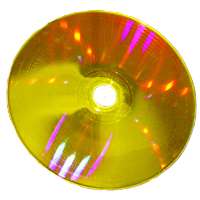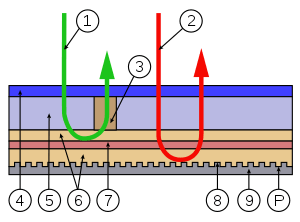Holographic Versatile Disc
The Holographic Versatile Disc (HVD) is an optical disc technology developed between April 2004 and mid-2008 that can store up to several terabytes of data on an optical disc 10 cm or 12 cm in diameter. The reduced radius reduces cost and materials used. It employs a technique known as collinear holography, whereby a green and red laser beam are collimated in a single beam. The green laser reads data encoded as laser interference fringes from a holographic layer near the top of the disc. A red laser is used as the reference beam to read servoinformation from a regular CD-style aluminium layer near the bottom. Servoinformation is used to monitor the position of the read head over the disc, similar to the head, track, and sector information on a conventional hard disk drive. On a CD or DVD this servoinformation is interspersed among the data. A dichroic mirror layer between the holographic data and the servo data reflects the green laser while letting the red laser pass through. This prevents interference from refraction of the green laser off the servo data pits and is an advance over past holographic storage media, which either experienced too much interference, or lacked the servo data entirely, making them incompatible with current CD and DVD drive technology.[1]
 | |
 An HVD by Optware | |
| Media type | Ultra-high density optical disc |
|---|---|
| Encoding | MPEG-2, MPEG-4 AVC (H.264), HEVC (H.265), VVC (H.266) and VC-1 |
| Capacity | 6 TB |
| Developed by | HSD Forum |
| Usage | Data storage, High-definition video, QHD/WQHD & the possibility of Ultra HD |
Standards for 100 GB read-only holographic discs and 200 GB recordable cartridges were published by ECMA in 2007,[2][3] but no holographic disc product has ever appeared in the market. A number of release dates were announced, all since passed,[4] likely due to high costs of the drives and discs itself, lack of compatibility with existing or new standards, and competition from video streaming.
Technology

1. Green writing/reading laser (532 nm)
2. Red positioning/addressing laser (650 nm)
3. Hologram (data)(shown here as brown)
4. Polycarbonate layer
5. Photopolymeric layer (data-containing layer)
6. Distance layers
7. Dichroic layer (reflecting green light)
8. Aluminium reflective layer (reflecting red light)
9. Transparent base
P. Pit pattern
(Illustration is not to scale.)
Current optical storage saves one bit per pulse, and the HVD alliance hopes to improve this efficiency with capabilities of around 60,000 bits per pulse in an inverted, truncated cone shape that has a 200 μm diameter at the bottom and a 500 μm diameter at the top. High densities are possible by moving these closer on the tracks: 100 GB at 18 μm separation, 200 GB at 13 μm, 500 GB at 8 μm, and most demonstrated of 5 TB for 3 μm on a 10 cm disc.
The system uses a green laser, with an output power of 1 watt which is high power for a consumer device laser. Possible solutions include improving the sensitivity of the polymer used, or developing and commoditizing a laser capable of higher power output while being suitable for a consumer unit.
Competing technologies
HVD is not the only technology in high-capacity, holographic storage media. InPhase Technologies was developing a rival holographic format called Tapestry Media, which they claim will eventually store 1.6 TB with a data transfer rate of 120 MB/s, and several companies are developing TB-level discs based on 3D optical data storage technology. Such large optical storage capacities compete favorably with the Blu-ray Disc format. However, holographic drives are projected to initially cost around US$15,000, and a single disc around US$120–180, although prices are expected to fall steadily.[5] Since InPhase Technologies were unable to deliver their promised product, they ran out of funds, and went bankrupt in 2010.[6]
Holography System Development Forum
The Holography System Development Forum (HSD Forum; formerly the HVD Alliance and the HVD FORUM) is a coalition of corporations purposed to provide an industry forum for testing and technical discussion of all aspects of HVD design and manufacturing.
As of March 2012, the following companies are members of the forum:[7]
- CBCGroup
- Daicel
- FujiFilm
- Konica Minolta Inc.
- Kyoeisha
- Pulstec
- Shibaura Mechatronics Corporation
- Oracle Corporation
- Teijin Chemicals Ltd.
- Tokiwa Optical Corporation
As of March 2012, the following companies are supporting companies of the forum:
- Kodate Laboratory
Standards
On December 9, 2004, at its 88th General Assembly, the standards body Ecma International created Technical Committee 44, dedicated to standardizing HVD formats based on Optware's technology.
On June 11, 2007, TC44 published the first two HVD standards:[8] ECMA-377,[2] defining a 200 GB HVD "recordable cartridge" and ECMA-378,[3] defining a 100 GB HVD-ROM disc. Its next stated goals were 30 GB HVD cards and submission of these standards to the International Organization for Standardization for ISO approval.[9]
General Electric
General Electric Global Research Centers created a holographic disc that could hold many times the data of a Blu-Ray — up to 500 GB.[10] As the technology is quite similar to CD, DVD, and Blu-ray technologies, the players were to be cross-compatible with these formats.
See also
- 5D DVD
- DVD
- Blu-ray Disc
- HD DVD
- Ultra Density Optical (UDO)
- Professional Disc for DATA (PDD or ProDATA)
- Holographic memory
- 3D optical data storage
- Magneto-optical drive (MO)
- Holographic Versatile Card
- Stacked Volumetric Optical Disk (SVOD)
- InPhase Technologies
References
- "What's New". August 23, 2004. Archived from the original on October 9, 2004.
- "Information Interchange on Holographic Versatile Disc (HVD) Recordable Cartridges – Capacity: 200 Gbytes per Cartridge". ECMA-377.
- "Information Interchange on Read-Only Memory Holographic Versatile Disc (HVD-ROM) – Capacity: 100 Gbytes per disk". ECMA-378.
- "Maxell focuses on holographic storage". CNET News.com. November 28, 2005. Archived from the original on July 22, 2012. Retrieved May 28, 2007.
- "Hitachi-Maxell to Ship Holographic Storage this Year". DailyTech. August 3, 2006. Retrieved May 28, 2007.
- "Holographic storage bites the dust".
- "HSD FORUM - HSDフォーラムについて / 会員リスト". Archived from the original on March 13, 2012.
- "Ecma releases new Holographic Information Storage Standards". Ecma press release. July 4, 2007.
- "Ecma standardizes Holographic Information Storage" (PDF). Ecma press release. January 26, 2005.
- Ganapati, Priya (April 27, 2009). "GE Holographic Breakthrough Squeezes 100 DVDs Into a Single Disc". Wired. Retrieved January 8, 2019.
External links
- DaTARIUS signs agreement with InPhase Technologies to be their sole sales, service and support supplier of Tapestry Media hardware and media to ship starting in 2007 (300 GB WORM discs) with 600 GB discs and re-writable technology in 2008 as well as 1.6 TB media available in 2010.
- Optware, creator of HVD format.
- InPhase, a now bankrupt, company that developed a competing holographic storage format.
- Video explaining holographic storage – PC Magazine, October 4, 2006
- Holography system rides single beam EE Times, February 27, 2006 – interview with Hideyoshi Horimai and Yoshio Aoki of Optware Corp.
- Holographic storage standards eyed EE Times, February 28, 2006 – article about the upcoming technical committee meeting to begin standardization of HVD.
- How stuff works explains how HVD works.
- Elusive Green Laser Is Missing Ingredient Wall Street Journal February 13, 2008
- General Electric unveils 500GB optical disc storage